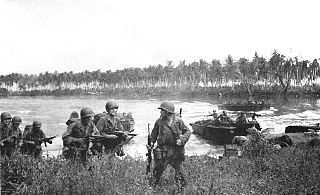
The Admiralty Islands campaign was a series of battles in the New Guinea campaign of World War II in which the United States Army's 1st Cavalry Division took the Japanese-held Admiralty Islands.
Momote Airport is an airport on Los Negros Island in the Admiralty Islands, Papua New Guinea. It also serves Manus Island, which is connected to Los Negros by a bridge.
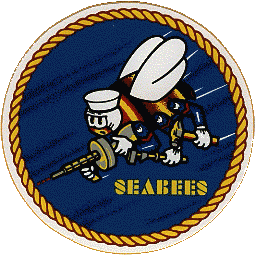
When World War II broke out the United States Naval Construction Battalions (Seabees) did not exist. The logistics of a two theater war were daunting to conceive. Rear Admiral Moreell completely understood the issues. What needed to be done was build staging bases to take the war to the enemy, across both oceans, and create the construction force to do the work. Naval Construction Battalions were first conceived at Bureau of Yards and Docks (BuDocks) in the 1930s. The onset of hostilities clarified to Radm. Moreell the need for developing advance bases to project American power. The solution: tap the vast pool of skilled labor in the U.S. Put it in uniform to build anything, anywhere under any conditions and get the Marine Corps to train it. The first volunteers came skilled. To obtain these tradesmen, military age was waived to age 50. It was later found that several past 60 had managed to get in. Men were given advanced rank/pay based upon experience making the Seabees the highest paid group in the U.S. military. The first 60 battalions had an average age of 37.

Pityilu Island is part of Manus Province in northern Papua New Guinea and part of the Admiralty Islands. It is off the northern coast of Manus Island and is nearly 4.8 km long and varies in width from 76 to 198 metres.
Lombrum Naval Base, also known as HMPNGS Tarangau and formerly PNG Defence Force Base Lombrum, is a naval military base operated by the Maritime Operations Element of the Papua New Guinea Defence Force (PNGDF). It is located on Manus Island in Papua New Guinea. Lombrum is the home port of the PNGDF's Pacific-class patrol boat force.

Naval Advance Base Espiritu Santo or Naval Base Espiritu Santo, most often just called Espiritu Santo, was a major advance Naval base that the U.S. Navy Seabees built during World War II to support the Allied effort in the Pacific. The base was located on the island of Espiritu Santo in the New Hebrides, now Vanuatu, in the South Pacific. The base also supported the U.S. Army and Army Air Corps, U.S. Coast Guard, and US Marine Corps. It was the first large advance base built in the Pacific. By the end of the war it had become the second-largest base in the theater. To keep ships tactically available there was a demand for bases that could repair and resupply the fleet at advance locations, rather than return them to the United States. Prior to December 7th, Pearl Harbor was the U.S. fleet's largest advance base in the Pacific. Espiritu became capable of all aspects necessary to support the Fleet's operations from fleet logistics in fuel, food, and ammunition, to transport embarkation for combat operations or returning to the continental United States. The ship repair facilities and drydocks were capable of attending to most damage and routine maintenance. Had it not existed, ships would have had to return to Pearl Harbor, Brisbane, or Sydney for major repairs and resupply. The base became a major R and R destination for the fleet.

US Naval Advance Bases were built globally by the United States Navy during World War II to support and project U.S. naval operations worldwide. A few were built on Allied soil, but most were captured enemy facilities or completely new. Advance bases provided the fleet with support to keep ships tactically available with repair and supply depots of facilities, rather than return them to the continental United States. Before Japan declared war on the United States the U.S. Navy had a single fleet-sized advanced base in the Territory of Hawaii at Naval Station Pearl Harbor. During the war the U.S. Navy Seabees built over 400 advance bases categorized by size. Naval bases were either Lions or Cubs while airfields were either Oaks or Acorns. Lions and Oaks were major facilities while Cubs and Acorns were minor. PT Boats typically would get a Cub and airfields with single runways were Acorns. The larger bases could do refueling and overhaul; loading of troopship and cargo ships; and preparing amphibious assault ships. Some became major repair depots. The Seabees developed auxiliary floating drydocks were able to repair battle damage and do regular maintenance in the field saving ships trans-pacific trips for repair. A few bases also were developed to be R and R for all U.S. personnel. Most Advance Bases were built by the US Navy's Seabees in Naval Construction Battalions (CBs). At the start of the war civilian contractors were employed in construction. The Seabees in World War II built most of the airfields used by the United States Army Air Forces and United States Marine Corps, as they had the ships and cranes needed to transport the vast amount of equipment needed at the advance bases. The US Army and United States Coast Guard also operated out of many of these facilities. Seabees could build new or repair damaged runways, and with advancements in heavy bomber technology lengthen runways as needed. A few Naval Advance Bases were built for the Korean War and Vietnam War.

Naval Base Milne Bay, also called Naval Advance Base Milne Bay, was new major United States Navy sea and airbase base built on Milne Bay in Milne Bay Province in south-eastern Papua New Guinea. By spring 1943, the build up of the US Navy to support the Pacific War had caused overcrowding at the ports on the east coast of Australia. To help, Seabees departed Naval Base Brisbane on June 19, 1943 to set up a new base in Milne Bay. Naval Base Milne Bay headquarters was at Ladava Navy Base. The Royal Australian Navy already had a small base in Milne Bay: HMAS Ladava. Australians were able to defend and keep Milne Bay in the Battle of Milne Bay in 1942. Naval Base Milne Bay was built during World War II to support the many ships and aircraft fighting and patrolling in the South West Pacific theatre of war. Ladava Navy Base provided a large protective US Navy fleet anchorage at Gahora Bay next to Ladava. At Naval Base Milne Bay, Seabees built a large Naval facility.

Manus Naval Base was a number of bases built after the World War II Battle of Manus by United States Navy on the Manus Island and a smaller island just east, Los Negros Island in the Admiralty Islands chain. The major naval base construction started with the Los Negros landings on February 28, 1944. The Navy repaired and did the expansion of the airfields on the Admiralty Islands. United States Navy Seabee built or repaired the facilities on the islands. The large Manus Naval Base, also called the Admiralty Island base, supported United States Seventh Fleet, Southwest Pacific command, and part of the Pacific Fleet. The base was abandoned by the US Navy after the war.

Naval Base Brisbane was a major United States Navy base built in the early part of World War II at Brisbane, Queensland, Australia. At first, operated as a base for patrol aircraft and convoy escort aircraft to protect the last leg of the Pacific War to the Southwest Pacific. As the US Navy expanded in the island hopping campaign, Naval Base Brisbane expanded to include a submarine base, repair depot, seaplane base and other facilities. US Navy operations started on April 14, 1942, and ended after the war in 1945.

Naval Base Merauke was a United States Navy base built during World War II at city of Merauke in the South Papua province of Indonesia, then Papua New Guinea. The base was 2 miles from the mouth of the Merauke River. The US Navy built a PT boat base and base dock with anchorage to support the Pacific War and the New Guinea campaign.
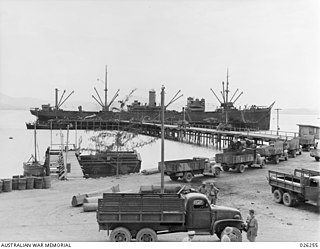
Naval Base Port Moresby was a United States Navy base built during World War II at the city of Port Moresby on Papua New Guinea. The US Navy built a communication center and advance base headquarters for the US Seventh Fleet to support the Pacific War in 1943. The base was part of the New Guinea campaign.

Naval Base Woodlark Island was a United States Navy base built during World War II on Woodlark Island on Papua New Guinea. The US Navy built a PT boat base, boat repair depot, and harbor facilities at the city of Guasopa to support the Pacific War in 1943. The Harbor facilities was also built to support the US Navy in building the Narewa Airfield on the island. The base was part of the New Guinea campaign.
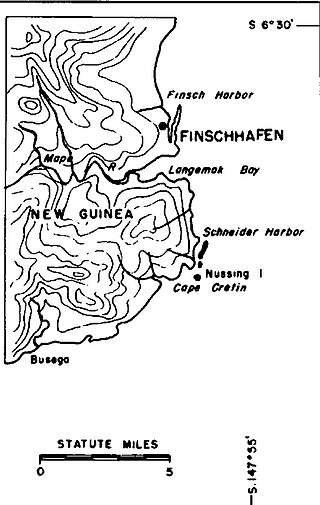
Naval Base Finschhafen was a United States Navy base built during World War II at Finschhafen on the Huon Peninsula in Morobe Province of Papua New Guinea. The US Navy built a PT boat base, Dreger Harbor PT Boat Base, boat repair depot, and harbor facilities at Dreger Harbour and Langemak Bay to support the Pacific War in 1943. Harbor was also built to support the US Navy in building 6,000-foot Finschafen Airfield, also called Dreger Field, now Finschhafen Airport on the island. The base was part of the New Guinea campaign.

Naval Base Hollandia was a United States Navy base built during World War II at Humboldt Bay, near the city of Hollandia in New Guinea. The base was built by the US Navy Seabees during the Battle of Hollandia, starting on May 9, 1944. Later Naval Base Hollandia became a supply base to support the invasion of the Philippines that started on October 20, 1944. Naval Base Hollandia became an advance headquarter of the United States Seventh Fleet.

Naval Base Puerto Princesa, Naval Base Palawan, was a United States Navy base built during World War II at Puerto Princesa on Palawan Island, Philippines, after the Invasion of Palawan on February 28, 1945. Puerto Princesa Bay offered an excellent base for fleet anchorage. At the naval base, US Navy Seabees built: a seaplane base, carrier aircraft fighter plane repair depot, land airfield and other base facilities.
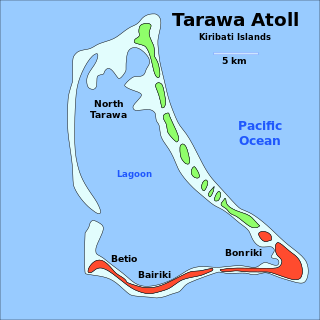
Naval Base Tarawa was a naval base built by the United States Navy in 1943 to support the World War II effort. The base was located on Tarawa atoll in the Gilbert Islands in the Central Pacific Ocean. The base was built as one of many advance bases in the island-hopping campaign towards the Empire of Japan. At Naval Base Tarawa the Navy built a seaport, seaplane base and two airbases. Construction started after the Battle of Tarawa ended November 23, 1943, part of Operation Galvanic.

Naval Base Fiji was a naval base built by the United States Navy in 1942 to support the World War II effort. The base was located on Fiji in the Central Pacific Ocean. The base was built as one of many advance bases in the island-hopping campaign towards the Empire of Japan. The US Navy built seaports, seaplane bases and airfields used for staging in the Pacific War.

Naval Base Gilbert Islands were naval bases built by the United States Navy in 1943 to support the World War II effort. The bases were located on in the Gilbert Islands in the Central Pacific Ocean. The bases were built as part of the many advance bases in the island-hopping campaign towards the Empire of Japan. The largest base was the Naval Base Tarawa. At Tarawa the Navy built a seaport, supply depots, a small ship repair depot, Carrier Aircraft Service Unit, seaplane base and two airbases. Construction started after the Battle of Tarawa ended on November 23, 1943, part of Operation Galvanic. The bases were built by the US Navy's Seabees, Naval Construction Battalions. After the war the bases were abandoned. Some of the airfields became civilian airports.

Naval Base Majuro was a major United States Navy base built on Majuro Atoll, in the Marshall Islands to support the World War II efforts in the Pacific War. The base was built after the Battle of Majuro-Kwajalein ended 3 February 1944. Majuro was found to be unoccupied and abandoned when the United States Army arrived. The US Navy built airfields, seaport, and other facilities on the captured islands. The base was part of the vast Naval Base Marshall Islands.



















